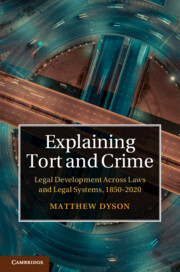Book contents
- Explaining Tort and Crime
- Explaining Tort and Crime
- Copyright page
- Contents
- Foreword
- Preface
- Table of Cases
- Table of Legislation
- Part I Setting the Scene: Introduction and Methods for Explaining
- Part II Mental States and Careless Acts: The Development of Fault Doctrine in Crime and Tort
- Part III Procedures Interfacing Tort and Crime
- Part IV Conclusions
- 9 Tracing Patterns of Development
- 10 Conclusion
- Index
9 - Tracing Patterns of Development
from Part IV - Conclusions
Published online by Cambridge University Press: 07 July 2022
- Explaining Tort and Crime
- Explaining Tort and Crime
- Copyright page
- Contents
- Foreword
- Preface
- Table of Cases
- Table of Legislation
- Part I Setting the Scene: Introduction and Methods for Explaining
- Part II Mental States and Careless Acts: The Development of Fault Doctrine in Crime and Tort
- Part III Procedures Interfacing Tort and Crime
- Part IV Conclusions
- 9 Tracing Patterns of Development
- 10 Conclusion
- Index
Summary
This Part brings together the threads from Parts I, II and III to explore what patterns of development we can identify, understand and compare across legal systems (Chapter 9) and concludes with some brief reflections on what we have learnt about the relationship between tort law and criminal law (Chapter 10). Part I’s methodology is a key background to understanding the interactions highlighted in this Part. For example, we see the importance of demarcating domains of study: Part II explained the generally low levels of interaction despite the terminological and functional overlap of tort and crime fault doctrines, while Part III showed how strong interactions on a procedural level might be, at specific points in time. We have also seen the axes of Hierarchy/Equality, Partition/Porosity and Iin/Directness in how the two areas have interacted or not interacted.
- Type
- Chapter
- Information
- Explaining Tort and CrimeLegal Development Across Laws and Legal Systems, 1850–2020, pp. 449 - 476Publisher: Cambridge University PressPrint publication year: 2022

